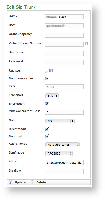| Subtitle | ||||||
|---|---|---|---|---|---|---|
| ||||||
In
| Xref | ||
|---|---|---|
|
- NAME: a meaningful name for this trunk
- HOST: IP address/hostname of the SIP server provided by ITSP
- PORT: this is 5061 by RFC
- TRANSPORT: TLS
- ENCRYPTION: check it enabled
- DIRECTMEDIA: check it enabled
- SENDRPID: check it enabled
The default values for Port, Allow and Disallow are usually work well, however feel free to change them to suite your needs better.
Optional fields are:
NAT: check this box only if you are not using directly the public IP address on the trunk interface.
| Note |
|---|
No interface binding for the trunk! The trunk would use the default gateway you configured in the PSAM 2.1 Network Configuration |
We do also suggest the following values to be set:
- AUDIO TONES: ON EARLY MEDIA
- works fine with the Cisco
- Unified Communications Manager.
- DTMFMODE: choose your values considering the PBX on the other end of the Trunk. Usually we suggest to choose the value RFC2833
- DIRECTMEDIA: enabled (checked)
- SENDRPID: enabled (checked)
Other fields in the form depend by your network topology and by the features on the other end PBX.
When you are done with your changes, commit them by clicking on the Update icon.
4.1.1 Certificate Management
In order to validate a TLS peer for establishing an Encrypted SIP Trunk, you generally have to import the other party CA Root. This is important because the peer TLS certificate could not match PrivateServer actual Certificate Chain and thus the validation would fail.
| Info |
|---|
PrivateServer comes with a bundle of the most known CA Roots certificates ready to be used. So this section is useful for minor certificate authorities and/or for self signed certificates. |
Please read 2.3.3 Add certification authority to understand how to import a new CA Root certificate.
| Navbar |
|---|
